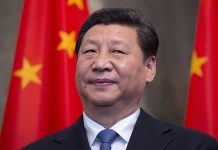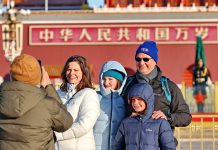BEIJING: The Chinese capital tightened anti-epidemic measures and urged all departments to fend off COVID-19 flare-ups in the city with all-round measures ahead of the Winter Olympics, after four COVID-19 infections, with both the Delta and Omicron variants, were detected in three days.
The four positive cases made Beijing the third region after Central China’s Henan Province and South China’s Guangdong Province that is battling both Delta and Omicron at the same time in the Chinese mainland, according to Global Times on Wednesday.
Among the four cases, two are in the same chain of transmission with the first case, which was infected with the Omicron variant, that is suspected of tracking back to an international package from Canada.
However, the source of the origin for the patient from Chaoyang district, who was infected with Delta, has not yet been confirmed, and the epidemiological investigation is still underway, the Beijing Center for Disease Control and Prevention said.
Experts said that epidemic risks in the capital city mainly come from the case in Chaoyang, because the final epidemiological study and source of origin of the positive case in the district has yet to be confirmed.
But the anti-epidemic group in Beijing has already acted swiftly in a bid to cut off further viral transmission within the city, and given the country’s experience in handling Omicron and Delta, the capital city’s domestic flare-up should be controllable very soon and would cause a limited impact on the Olympics.
The residential compound of the positive case, and the neighboring Shigezhuang village and Dingfuzhuang in Chaoyang district, were temporarily sealed off on Tuesday afternoon, media reports said.
The case in Chaoyang is a migrant worker. The person had a cold around January 14 before testing positive and immediately being quarantined. The person was on a high-speed train to East China’s Shandong Province’s Weihai city, Beijing’s CDC noted.
The current situation is severe and complicated. In face of dual pressure from inbound and imported cases, the city has reported more COVID-19 infections. This shows the complexity and challenge of epidemic prevention and control in the capital city, Xu Hejian, the spokesperson of the Beijing municipal government, said at a press conference.
In the wake of two mutated variants, Xu stressed that all departments should be vigilant to fend off COVID-19 with all-round measures.
COVID-19 in the city must be contained with speedy measures. Citywide resources should be allocated to the anti-epidemic work, Cai Qi, Party chief of Beijing, who led the city’s anti-epidemic group, said during a meeting.
Cai stressed locating the sources of origins and quarantining all possibly related people in the first case.
Meanwhile, anti-epidemic measures involving people and goods should get the same priority, and it’s important to prevent packages from overseas causing domestic COVID-19 flare-ups.
Local government officials also said at the press conference on Tuesday that people entering Beijing should take nucleic acid tests within 72 hours and report to their places of residence.
The local government will comprehensively screen key-risk personnel and not miss a single risk of the virus spreading.
The detection of the four positive cases comes a few days before the Winter Olympics.
A Beijing-based immunologist surnamed Wang told the Global Times that the epidemic in Beijing will bring complications to the Games, but the impact will be very limited.
Despite the risks, Beijing’s handling of epidemic prevention and control has proven it to be one of the model cities, capable of containing the virus quickly, Wang said.
Experts said that the scale of the outbreak in Beijing would not be as large as in Henan or Tianjin. First, the outbreak in Haidian has a clear source, and all related people were quarantined, which brought the risk of further spread down greatly.
Second, compared with Henan and Tianjin, which had substantial community transmission in a short time, Beijing’s cases are merely at the single-digit level.
Apart from Beijing, at least nine more regions in China are dealing with COVID-19.
For example, the neighboring city Tianjin is still handling the first local cluster triggered by the Omicron strain in the Chinese mainland, and it had 312 confirmed cases as of Tuesday.
But Tianjin has so far effectively controlled the outbreak within the region, and contained the spread and spillover.
Anyang, Central China’s Henan Province, which is also battling Omicron, reported a total of 404 confirmed cases since January 8. All of them were quarantined, the local anti-epidemic group said at Tuesday’s press conference.
As the country is facing a head-on challenge from the highly contagious Omicron variant, the State Council recently approved a 20:1 pooled sampling approach for mass nucleic acid testing, which is believed to increase the efficiency and reduce the cost for mass testing.
Mass testing is one of the key methods for the country’s sustained containment of COVID-19 with the dynamic zero-case policy. -The Daily Mail-Global Times News Exchange Item





